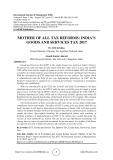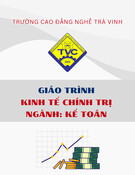
http://www.iaeme.com/IJM/index.asp
119
editor@iaeme.com
International Journal of Management (IJM)
Volume 8, Issue 1, January – February 2017, pp.119–126, Article ID: IJM_08_01_013
Available online at
http://www.iaeme.com/ijm/issues.asp?JType=IJM&VType=8&IType=1
Journal Impact Factor (2016): 8.1920 (Calculated by GISI) www.jifactor.com
ISSN Print: 0976-6502 and ISSN Online: 0976-6510
© IAEME Publication
TAX REFORM FOR DEVELOPING VIABLE AND
SUSTAINABLE TAX SYSTEMS IN INDIA WITH
SPECIAL REFERENCE TO GST
Suraj M. Shah
Assistant Professor, V M Patel institute of Management (Faculty of Management),
Ganpat University, Gujarat, India
Dr. Nirav R. Joshi
Assistant Professor,V M Patel institute of Management (Faculty of Management),
Ganpat University, Gujarat, India
ABSTRACT
Most developing countries continue to face severe issues in developing adequate and quick to
respond tax systems. While each of these paths to reform is necessary, in the end what 50 years of
experience tells us is that improving the precision and understanding with which fiscal issues both
within and outside government, is the really essential ingredient to developing viable and
sustainable tax systems in developing countries like India. Indian taxation system has undergone
remarkable reforms during the last decade. The tax rates have been rationalized and tax laws have
been simplified resulting in better compliance, ease of tax payment and better enforcement. The
process of validation of tax administration is ongoing in India.
Another key objective of tax reform measures has been to increase total tax to GDP ratio as a
means of achieving fiscal consolidation and improving resource allocation. GST, easier tax filing
methodology and simpler tax structures – Government of India is working to enhance the
government's revenue collection, at the same time ensuring that cumbersome taxes do not deter
investors. This paper review the three principal ways in which developing countries like India may
develop and progress their taxation systems - base-broadening, rate reduction, and administrative
improvement - in the context of the political economy of tax reform.
Key words: Tax reform, GST, Developing viable and sustainable tax systems.
Cite this Article: Suraj M. Shah and Dr. Nirav R. Joshi, Tax Reform for Developing Viable and
Sustainable Tax Systems in India with Special Reference to GST. International Journal of
Management, 8(1), 2017, pp. 119–126.
http://www.iaeme.com/IJM/issues.asp?JType=IJM&VType=8&IType=1

Suraj M. Shah and Dr. Nirav R. Joshi
http://www.iaeme.com/IJM/index.asp 120 editor@iaeme.com
1. INTRODUCTION
1.1. Concept of Tax Reforms
Philosophy of tax reform has been changed considerably over the years with the changing perception of the
role of state in tax policy and activities. In recent time, the market oriented tax policies are preferred to
social one. Designing tax policy and reforming existing tax system are two different things. Anushuya; Pal,
Narwal Karam,(2014). Tax is the major source of revenue to government in India. Taxes are levied as per
the laws prescribed in constitution of India. It is levied by central and state government and also by local
bodies. The Development of any country’s economy depends directly on the Country’s Taxation Structure.
A Taxation Structure which facilitates easy of doing business and having no chance for tax evasion brings
prosperity to a country’s economy. In India, the Taxes are classified in to two types, direct taxes and
indirect taxes. Direct Taxes are those which are paid directly by the individual or organization to the
imposing authority. They are levied on income and profits Indirect Taxes are those which are not paid
directly by the individual or organization to the imposing authority. They are levied on goods and services
and not on income and profits. Direct Taxes such as Corporation tax, Taxes on income, Estate duty,
Interest Tax, Wealth Tax, Gift Tax, Land Revenue, Agricultural tax, Hotel receipts tax, Expenditure tax &
Indirect Taxes such as Customs, Union excise duties, Service tax, State Excise duty, Stamp and
registration fees, General Sales tax, Taxes on vehicle, Entertainment tax, Taxes on goods and passengers,
Taxes and duties on electricity & Taxes on purchase of sugarcane. Taxation is a very important and critical
source for the development and growth of an economy. Objectives of the tax policy of a country should be
parallel to its general economic policy. The key part of income of a government comes from taxes whether
it is direct tax or indirect tax. A sound tax system is vital for the development of the excellent strength of
public finance of any country. That's the reason; various taxation reforms in dissimilar countries are being
witnessed in the period of globalization.
The world has witnessed major reforms in tax policies and systems since last two-three decades. These
reforms are mainly in support of the expansion policy of the financial system, increasing globalization, the
motivation to make the tax system in tune with international best practices and discover some answer for
financial difference. India is no exclusion of it. The main specialty of Indian tax system lies on
constitutional powers. Taxes are levied at both centre and state level. Some taxes are also levied by local
authorities. Schedule VII of Indian constitution enumerates powers to levy taxes into three lists.
1.2. Need for Comprehensive Reforms
On the other hand taxation structure which has provisions for tax evasion and the one which does not
facilitate ease of doing business slows down the growth of country’s economy. Therefore as taxation
structure plays an important role in country’s development. There is always need for study of the taxation
structure to make the Taxation structure more simple that earlier.
While the proposed Goods and Services Tax (GST) is usual to widen the base of indirect taxes,
complete administrative and legal reforms are required to control huge avoidance of direct taxes in India.
Perhaps the time has come for reforming the direct tax reforms. Kavaljit Singh, (2016), Reforming the
Direct Tax Reforms in India.
The major reforms being undertaken in Indian Taxation System in reference to Indirect Taxation
System is presented in below:

Tax Reform for Developing Viable and Sustainable Tax Systems in India with Special Reference to GST
http://www.iaeme.com/IJM/index.asp 121 editor@iaeme.com
Table 3 Reforms in Indirect Taxation System Year
Reforms in Indirect Taxation
System Year
Reforms
1974 Report of LK Jha Committee suggested VAT should be
introduced
1986 Introduction of a restricted VAT called MODVAT
1991 Report by the Chelliah Committee recommended either VAT or
GST which was accepted by Government
1994 Introduction of Service Tax @ 5%
1999 Formation of Empowered Committee on State VAT
2000 Implementation of uniform floor rate of tax for VAT at the rate
1%, 4% and 12.5%. and Abolition of tax related incentives
granted by States
2003 VAT implemented in Haryana in April 2003
2004 Significant progress towards CENVAT, MODVAT was
abolished and credit account was merged with service tax and
excise to provide for cross utilization.
2005-06 VAT implemented in 26 more states
2007
First GST released By Mr. P. Shome in January
Finance Minister announces for GST in budget Speech and
CST phase out starts in April 2007. Then, Joint Working Group
formed and submitted report
2008 EC finalizes the view on GST structure in April 2008
2009 First discussion paper on GST was released and commission
submitted report proposing GST to be implemented from
1.4.2010
2010 Department of Revenue commented on GST discussion paper
and Finance Minister suggested probable GST rate.
2011 Team was set up to lay down road map for GST and 115th
Constitutional Amendment Bill for GST was laid down in
Parliament
2012 Negative list regime for service tax was implemented
2013 Parliamentary Standing Committee submitted its report on the
Bill
2014 115th Amendment Bill lapsed and was reintroduced in 122nd
Constitutional Amendment Bill
Source: Akanksha Khurana, Aastha Sharma, (2016)
1.3. Goods and Service Tax as a Tax Reform Tool
Traditionally Indirect taxes specially excise and custom duty had a big share in Indian tax revenue until
reforms of 1991 were implemented. Reforms in 1991 laid roadmap for simplification in indirect tax
structure. The share in total tax revenue is decreased. Since then there are various reforms in Indian
Taxation history such as introduction of MODVAT, service tax, CENVAT and state VAT. They are
mostly concerned with reduction in exemption list to broaden the base and reduction in tax rate.
Traditionally Sales tax is producer based that has various limitations. Each reform recommended by
various committees suggested ways to come near consumption based tax. India is presently at the step of
the revolutionary change in its taxation policy. The most recent phase of tax policy reforms in India
witnessed the introduction of an important legislature i.e. constitutional amendment bill to introduce the
Goods and Services Tax (GST). The Good and services tax (GST) is the biggest and considerable indirect
tax reform since 1947. The main idea of GST is to replace existing taxes like value-added tax, excise duty,

Suraj M. Shah and Dr. Nirav R. Joshi
http://www.iaeme.com/IJM/index.asp 122 editor@iaeme.com
service tax and sales tax. It will be levied on manufacture sale and consumption of goods and services.
Goods and Service tax bill officially known as the constitution (one hundred and twenty second
amendment) bill, 2014 proposes a national value added tax to be implemented in India from June 2016.
The GST implementation in India is ‘Dual’ in nature, i.e. it would consist of two components: one levied
by Centre (CGST) and another levied by States and Union Territories (SGST). However, base of tax levy
would be identical. Under the GST scheme, no distinction is made between goods and services for levying
of tax. This means that goods and services attract the same rate of tax. GST is a multi-tier tax where
ultimate burden of tax fall on the consumer of goods/services. It is called as value added tax because at
every stage, tax is being paid on the value addition.
GST is proposed to perform the following objectives:
• GST would help to remove the cascading effects of production and distribution cost of goods and services.
This would help to increase GDP and then to economic condition of the country.
• GST would remove the multiplicity of indirect taxation and reorganize all the indirect taxes which would be
beneficial for manufacture and ultimate consumer.
• GST would be able to cover all the shortcomings of active VAT system and hopefully serve the economy
health.
• Incidence of tax falls on household consumption
• The efficiency and equity of system is optimized
• There should be no export of taxes across taxing jurisdiction
• The Indian market should be integrated into single common market
• It enhances the cause of co-operative federalism.
2. REVIEW OF LITERATURE
• Indian tax system is guided by a multifaceted set of laws and policies. Extensive avoidance of tax is an issue
of concern (Eigner, Richard M, 1959).
• Tax compliance can be improved by implementing simple reforms in personnel policy in Indian income tax
administration. Taxpayers voluntarily disclosing higher income are currently assigned to special assessment
units. Therefore, taxpayers minimize their income. (Das-Gupta, Arindam; Ghosh, Shanto; Mookherjee,
Dilip, 2004)
• In India, some tax structure changes were implemented to reduce tax evasion. It included changes in tax rate
structure and deductions. (Das-Gupta, Arindam; Gang, Ira N ,2000).
• A series of steps were taken by the Customs and excise Department, Government of India, to diminish
corruption and stop leakages of revenue in customs and excise tax collection and management.
Liberalization and generalization of laws and procedures was implemented. It reduced corruption and
enhanced revenue collection. (Jayaraman Vijayakumar; Rasheed, Abdul A; Krishnan, V S ,2005).
• Value added tax (VAT) is a type of indirect tax that is imposed on goods and services. Sometimes, when the
government operates on a budget surplus or wants to increase its income in order to finance its budget
shortfall. In one of the most large scale reforms of the country’s public finances in over the past 50
years, India has finally agreed the initiate of its much delayed value added tax from 1st April, 2005 at a rate
of 12.5%. The tax rate is fixed by conference of different state level Finance Minister, in New Delhi,
designed to build accounting clearer, to cut short employment barriers and improve tax revenues. (Tripathi,
Ravindra; Sinha, Ambalika; Agarwal, Sweta ,2011).
• The Report of the India, Taxation Enquiry Commission, 1953-54 is an essential involvement to official
literature on taxation. Appointed in April 1953, the Commission was charged with making a systematic
assessment of central, state, and local taxation in order to decide the occurrence. (Goode, Richard ,1956).
• It is estimated that a 3 point expansion in the corruption awareness index would almost twice the tax
corporate tax collection in India.(Ketkar, Kusum W; Murtuza, Athar; Ketkar, Suhas L ,2005)
• Together direct and indirect taxes are affected by inter governmental transfers. (Dash, Bharatee Bhusana;
Raja, Angara V,2013).

Tax Reform for Developing Viable and Sustainable Tax Systems in India with Special Reference to GST
http://www.iaeme.com/IJM/index.asp 123 editor@iaeme.com
• (Kumat, 2014)in his research paper examined that there should be a coordinated use tax system. He also
states that getting improved the capability of Indian tax system continues to be a key challenge in India.
• (Jha, 2013)in his research paper suggested that high reliance on indirect taxes should be reduced and direct
taxes should be in increased on wealthy to pay off the losses.
• (Rao, 2005)in his research paper on Tax system reforms in India: achievement and challenges ahead focuses
on the union and state level reforms. He concluded that the reforms are just the beginning and considerable
distance in reforming the tax system is yet to be covered.
• Empowered Committee of Finance Ministers (2009) introduced their First Discussion Paper on Goods and
Services Tax in India which analyzed the structure and loopholes if any in GST
• Vasanthagopal (2011) in the article GST in India: A Big Leap in the Indirect Taxation System discussed the
impact of GST on different sectors of the financial system. The article further stated that GST is a big jump
and a new force to India’s financial change.
• Bird (2012) summarizes in the article The GST/HST: Creating an integrated Sales Tax in a Federal Country
the impact of GST will be on Canada.
• Garg (2014) in the article named Basic Concepts and Features of Good and Services Tax in India analyzed
the impact and GST on Indian Tax scenario and concluded that it will strengthen out free market economy.
• Kumar (2014) studied in the article Goods and Services Tax in India: A Way Forward background, silent
features and concluded with the positive impact of GST on present complex tax composition and expansion
of common countrywide market.
• Indirect Taxes Committee of Institute of Chartered Accountants of India (ICAI) (2015) submitted a PPT
naming Goods and Serice Tax (GST) which stated in concise particulars of the GST and its positive impact
on economy and various stakeholders.
• Parkhi did an exploratory research in an article Goods and Service Tax in India: the changing face of
economy and stated that execution of GST is a altering features of India and the administration is healthy
equipped for that which is a sign of fast paced financial system.
2.1. Statement of the Problem
Indian taxation structure has gone throughout lots of reforms and still it is very far in front from being an
ideal taxation structure. Many problems like Tax Evasion, Reliance on indirect taxes, Black money and
existence of parallel financial system show that Indian taxation system requires some chief reforms in the
outlook ahead to speak to all this problems.
2.2. Objectives
The paper uses an exploratory research practice based on past literature from respective journals, reports,
newspapers and magazines covering wide collection of scholastic literature on Goods and Service Tax.
Available secondary data was extensively used for the study.
The objectives of the paper are:
• To find out effect of Goods and Service Tax as a tax reform tool and its impact on the economy.
• To find our various implications of Goods and Service tax in tax reform.
3. IMPACT OF GOODS AND SERVICE TAX IN VARIOUS SECTORS
Section 2, GST has a positive impact on the economy and on various sectors which are as follows:
3.1. Fast Moving Consumer Goods Sector
With the implementation of Goods and Service Tax, FMCG sector would really change. FMCG sector
consist 50% Food and Beverage sector and 30% is Household and Personal care. FMCG sector is the
major taxation contributor both direct and indirect in the financial system. FMCG companies set their
manufacturing units and warehouses where they can benefit tax benefits. To move the stock from the

![Câu hỏi ôn tập Phân tích chính sách thuế [chuẩn nhất]](https://cdn.tailieu.vn/images/document/thumbnail/2025/20250630/nhinhi_2512/135x160/9611751338066.jpg)
























